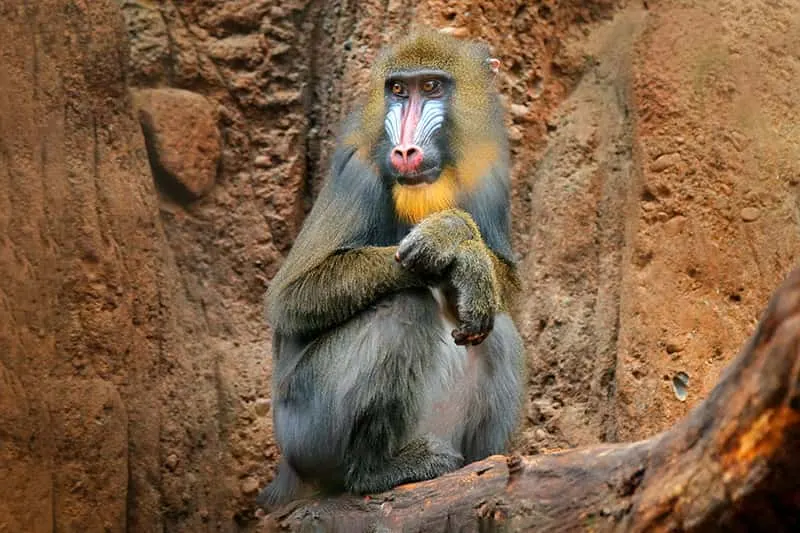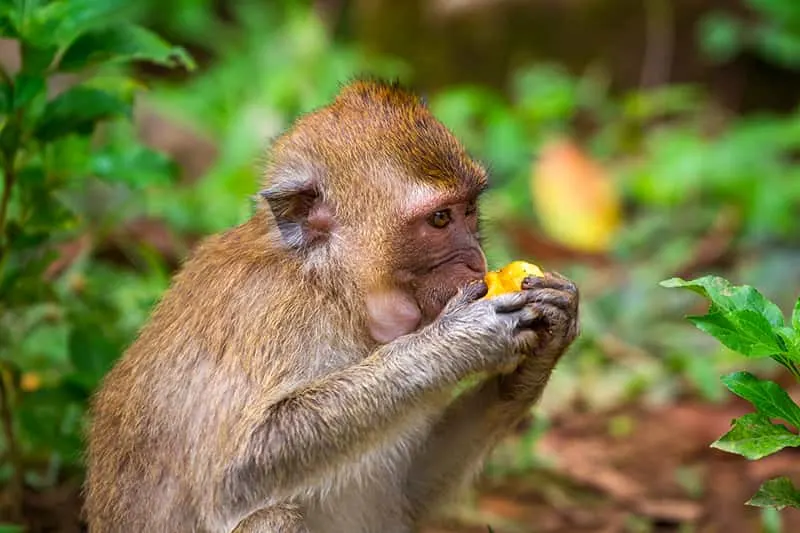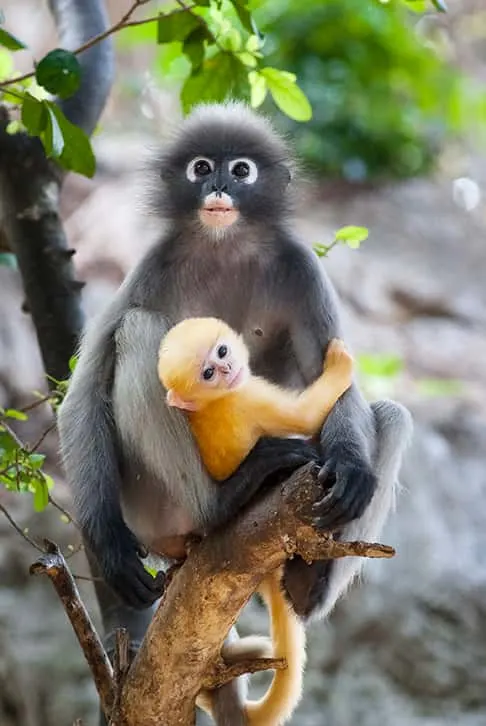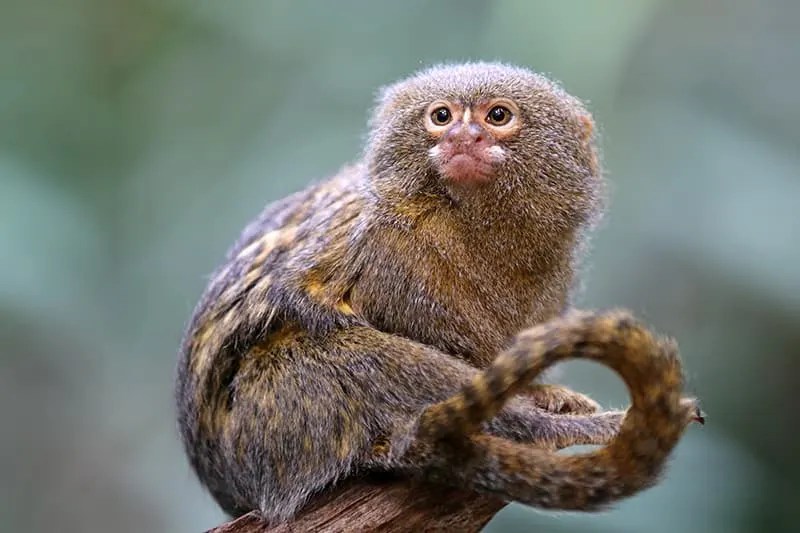Want to learn some monkey facts for kids? You’ll find them in this post. We’ll talk about their physical description, diet, offspring, and more!

There are a total of three hundred and thirty-four monkey species. These species are divided into two groups. There are one hundred and sixty “Old World” species and one hundred and seventy-four “New World” species. We'll discuss both groups of these interesting creatures!
Physical Description
Old World monkeys have characteristics that are different from those of New World monkeys. The noses of Old World monkeys are narrower than those of New World monkeys. Old World monkeys have nostrils that point downward, just like people do.
Old World monkeys have hard “pads” that offer protection when sitting on their bottoms. New World monkeys do not have these pads.
Many Old World monkeys have opposable thumbs, which they use for grasping things. New World monkeys do not have opposable thumbs. Old World monkeys have nails on their fingers and toes, while New World monkeys tend to have sharp claws.
Almost all monkeys have tails. Monkey’s tails range in length from very short to very long. Some New World monkeys have prehensile tails. These tails are long and used to grasp objects. Old World monkeys do not have prehensile tails.
Monkeys have a variety of different colors of fur. Monkeys range in color from black to red, yellow, and white. Many monkeys also have bright markings or color patterns. The markings or patterns are on the monkeys’ faces or bodies. All monkeys have two eyes that face forward and two ears.
Monkeys come in various sizes. The smallest monkey is the Pygmy marmoset. Pygmy marmosets only grow to be six inches tall. They weigh roughly three and a half ounces, which is about the weight of a deck of cards.
The largest monkey is the Mandrill. It can weigh up to seventy-seven pounds and is two feet tall. Male monkeys are typically bigger than females.

Habitat
Old World monkeys live in different regions than New World monkeys do. Old World monkeys are native to the African and Asian continents. They can be found in South Asia, East Asia, Africa, the Middle East, and Gibraltar. New World monkeys are native to the Americas. They can be found in South America, Central America, and Mexico.
Old World monkeys have a range of habitats. They live in rainforests, savannahs, deserts, snowy mountains, and urban areas. New World monkeys only have two types of habitats. They live in forests and subtropical woodland areas.
Habits
Most monkeys are active during the day. They divide their day into eating, traveling, and resting. They sleep about nine hours a night.
All monkeys are social creatures and live in groups. There are different types of groups. One type of group is a group with one male and many females. Another group is a “pair group”. This group is made up of parents and their offspring. Monkeys also have all male and all female groups.
Monkeys bond with each other through social grooming. Grooming not only keeps the monkeys clean, but it also helps them form bonds. Monkeys groom each other to express affection and make peace. Grooming is part of mating, but it is also an expression of friendship.

Diet
The diets of monkeys vary based on species, habitat, and season. Most monkeys are omnivores. They are opportunistic feeders, and both groups eat leaves and fruit.
Leaves are the main part of an Old World monkey's diet. Fruit is the main part of a New World monkey’s diet. Both groups of monkeys eat seeds, nuts, insects, and bird eggs.
Monkeys get the water they need from their food, bodies of water, and puddles.
Offspring
Old World monkey females are pregnant for about six months, which is a month longer than New World monkeys. Monkeys typically give birth to one infant.
Baby monkeys are helpless when they are born. Old World and New World monkey babies have different caregivers.

Only moms take care of Old World monkey babies. New World monkey babies are taken care of by both parents.
From the age of one to eighteen months, monkey babies rely on their mothers for care. Most monkeys become adults at three or four years old.
Classification/Taxonomy
• Kingdom: Animalia
• Phylum: Chordata
• Class: Mammalia
• Order: Primate
• Family: Mammal
History
After Old World monkeys, New World monkeys appeared. Old World monkeys first arose between five and twenty-three million years ago. Monkeys from the New World initially appeared some thirty million years ago.
Predators
Monkey predators differ depending on the size, type, and environment of the monkey. Some of the main predators of monkeys are large birds, big cats, hyenas, and reptiles like snakes and alligators.

Lifespan
Larger monkeys typically live longer than smaller ones. In the wild, smaller monkeys can live up to fifteen years, while larger ones can live up to twenty years. Monkeys in captivity tend to live longer than monkeys in the wild.
25+ Unusual Monkey Facts
- New World monkeys are “arboreal,” meaning they spend most of their time in trees.
- Old World monkeys prefer to spend their time on the ground rather than in trees.
- Monkeys can be found on all continents except Antarctica and Australia.
- Nonnative monkey populations have existed in Florida since they were released 50+ years ago.
- A group of monkeys is called a “troop.”
- Old World monkeys tend to be bigger than New World monkeys.
- Old World monkeys see in black and white.
- New World monkeys see in color like people do.
- The main difference between apes and monkeys is that apes lack a tail.
- Monkeys play to learn, practice social skills, and bond with others in their group.
- Monkeys communicate through visual cues and a variety of vocalizations.
- Nocturnal monkeys can sleep up to 17 hours a day.
- Bananas aren't a primary food source for wild monkeys.
- Old World monkeys have special cheek pouches that they use for storing food.
- Monkeys are revered in India because they are associated with a Hindu god.
- Capuchin monkeys are intelligent because they create and use tools.
- Babies of Old World monkeys are carried on their mother’s bellies.
- New World monkey babies are carried on their mothers’ backs.
- New World monkey babies are sometimes cared for by other group members.
- The scientific name of an Old-World monkey is Cercopithecoidea.
- The scientific name of a New World monkey is Platyrrhine.
- Baboons are the longest-living monkeys and can live up to forty years of age in the wild.
- Monkeys are well-known for their problem-solving abilities.
- Spider monkeys are known for their hooklike hands, prehensile tails, and hugging behavior.
- Howler monkeys make howls that can be heard a mile away through the rainforest.
- Howler monkeys are known for being the loudest land animals on the planet.
We hope you enjoyed learning all about monkeys. Did you learn anything new? Let us know what other facts you know! We can’t wait to hear more.
Here are some other fun mammals that you might want to learn about.
